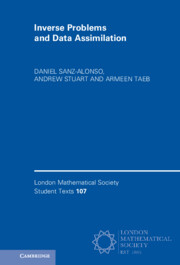Book contents
- Frontmatter
- Dedication
- Contents
- Preface
- Introduction
- Part I Inverse Problems
- 1 Bayesian Inverse Problems andWell-Posedness
- 2 The Linear-Gaussian Setting
- 3 Optimization Perspective
- 4 Gaussian Approximation
- 5 Monte Carlo Sampling and Importance Sampling
- 6 Markov Chain Monte Carlo
- Exercises for Part I
- Part II Data Assimilation
- 7 Filtering and Smoothing Problems and Well-Posedness
- 8 The Kalman Filter and Smoother
- 9 Optimization for Filtering and Smoothing: 3DVAR and 4DVAR
- 10 The Extended and Ensemble Kalman Filters
- 11 Particle Filter
- 12 Optimal Particle Filter
- Exercises for Part II
- Part III Kalman Inversion
- 13 Blending Inverse Problems and Data Assimilation
- References
- Index
10 - The Extended and Ensemble Kalman Filters
Published online by Cambridge University Press: 27 July 2023
- Frontmatter
- Dedication
- Contents
- Preface
- Introduction
- Part I Inverse Problems
- 1 Bayesian Inverse Problems andWell-Posedness
- 2 The Linear-Gaussian Setting
- 3 Optimization Perspective
- 4 Gaussian Approximation
- 5 Monte Carlo Sampling and Importance Sampling
- 6 Markov Chain Monte Carlo
- Exercises for Part I
- Part II Data Assimilation
- 7 Filtering and Smoothing Problems and Well-Posedness
- 8 The Kalman Filter and Smoother
- 9 Optimization for Filtering and Smoothing: 3DVAR and 4DVAR
- 10 The Extended and Ensemble Kalman Filters
- 11 Particle Filter
- 12 Optimal Particle Filter
- Exercises for Part II
- Part III Kalman Inversion
- 13 Blending Inverse Problems and Data Assimilation
- References
- Index
Summary
In this chapterwe describe the Extended Kalman Filter (ExKF)1 and the Ensemble Kalman Filter (EnKF). The ExKF approximates the predictive covariance by linearization, while the EnKF approximates it by the empirical covariance of a collection of particles. The ExKF is a provably accurate approximation of the filtering distribution if the dynamics are approximately linear and small noise is present in both signal and data, in which case the filtering distribution is well approximated by a Gaussian.
Information
- Type
- Chapter
- Information
- Inverse Problems and Data Assimilation , pp. 133 - 143Publisher: Cambridge University PressPrint publication year: 2023
